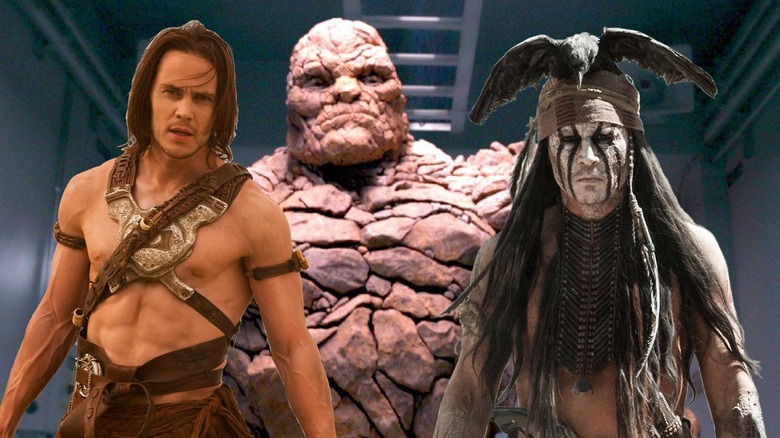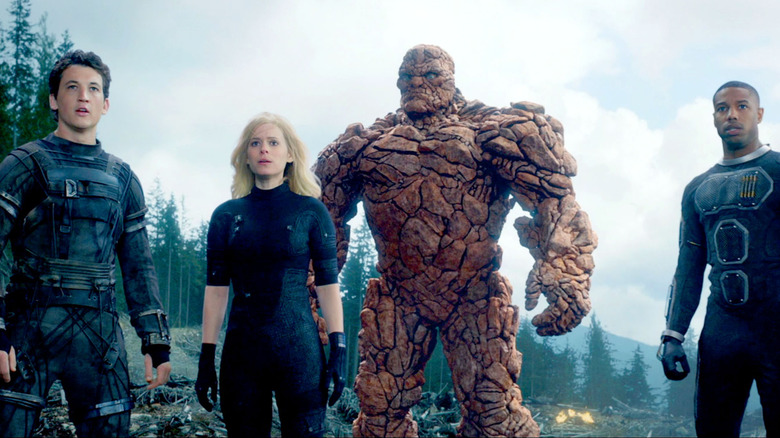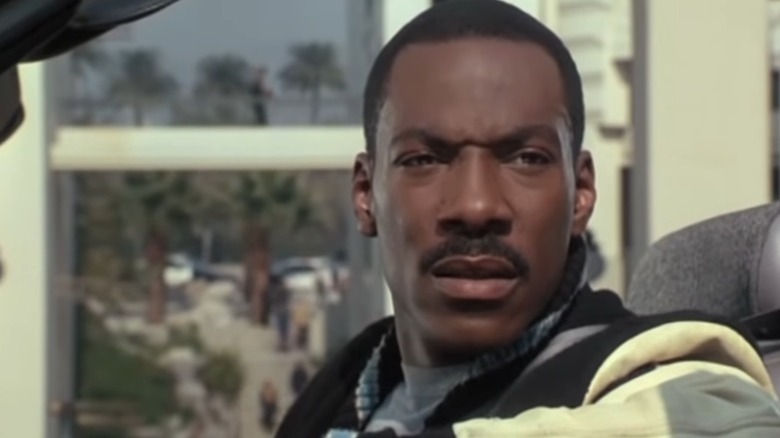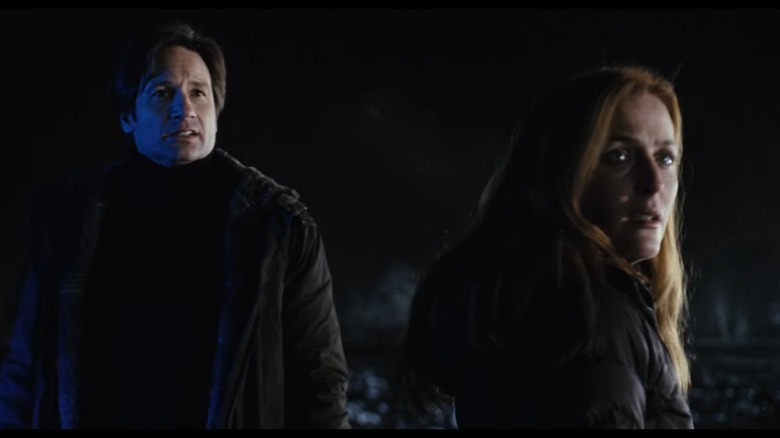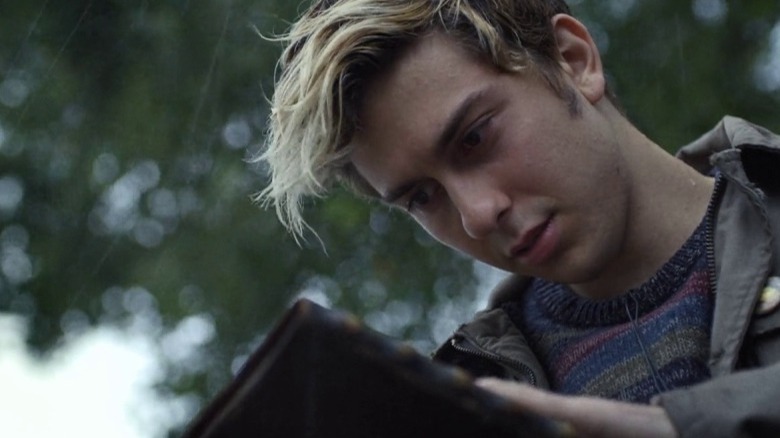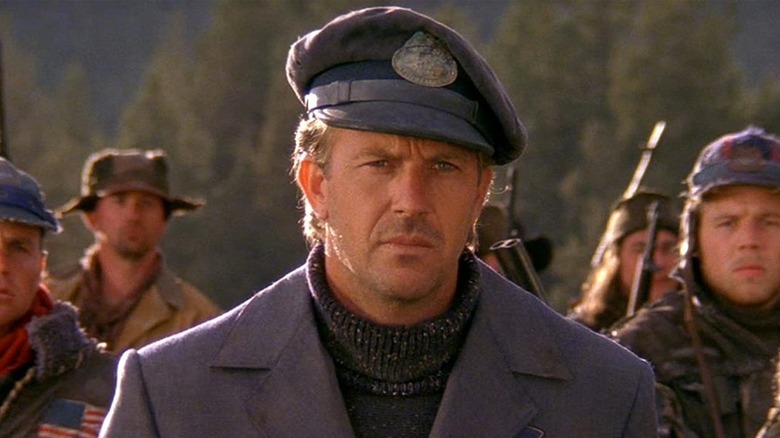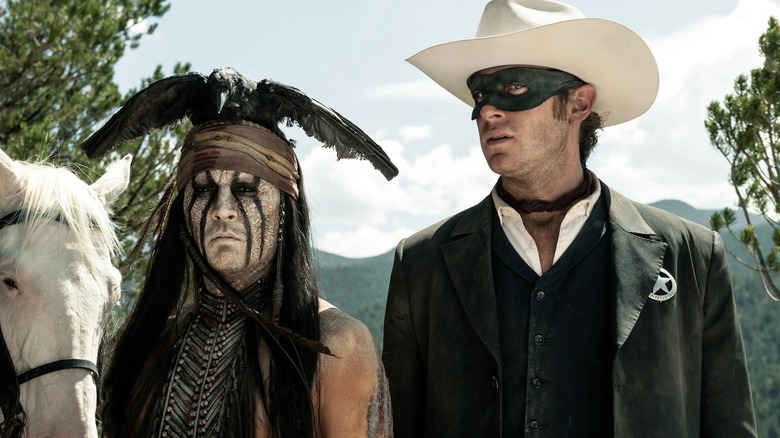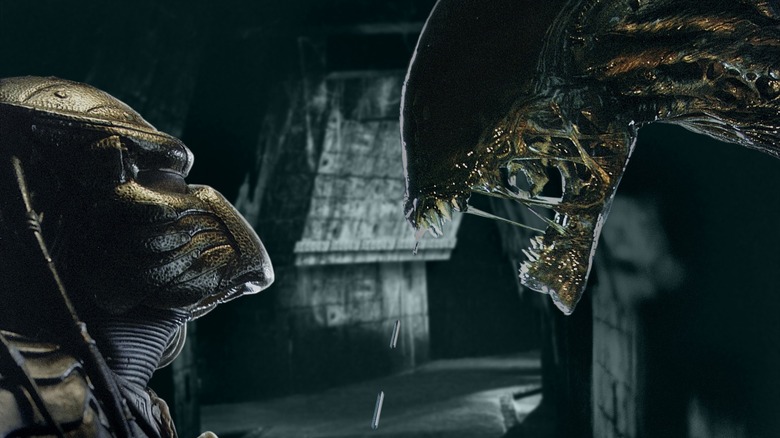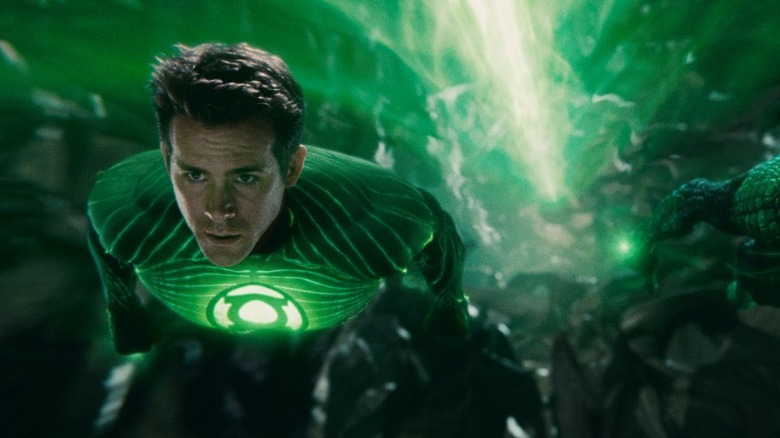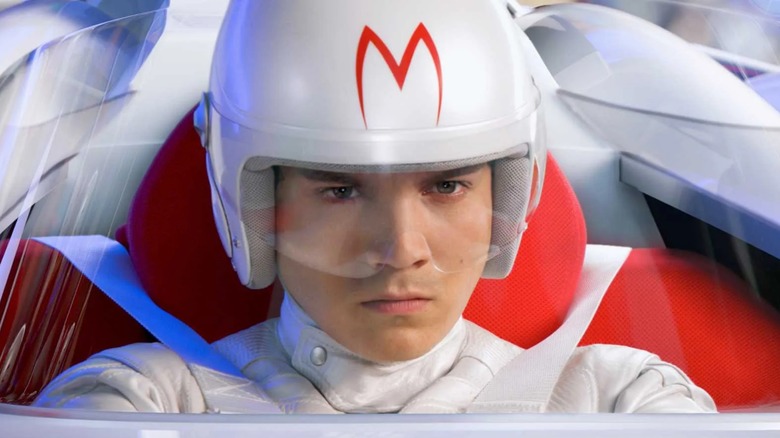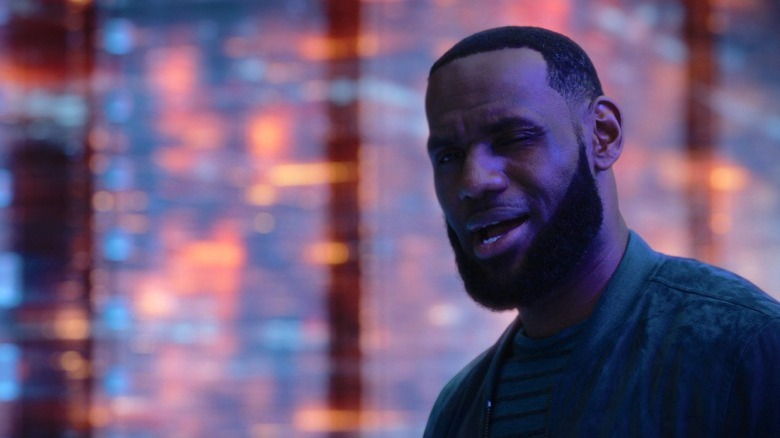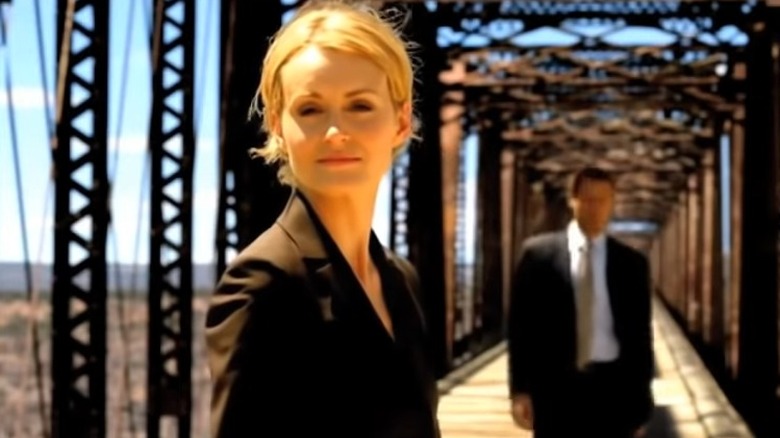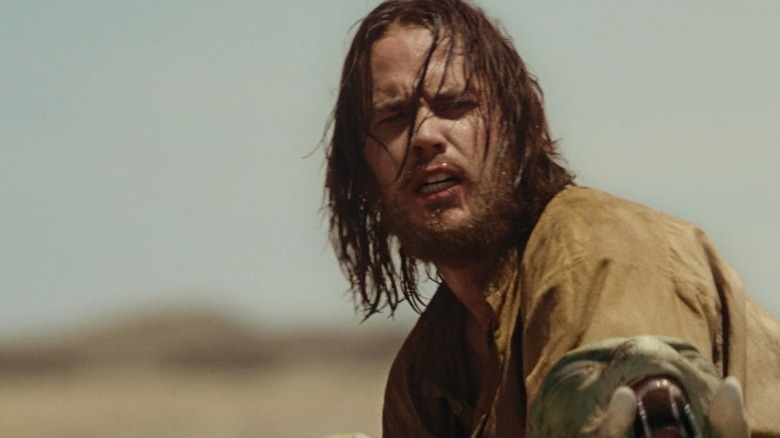Movies That Should Have Never Escaped Development Hell
Movies take lots of time, effort, and money to create; often, it can take years to fully develop a film before the cameras even roll. Typically, someone writes a script, which is then rewritten repeatedly — often by multiple people — up to and even during production. There's casting, location scouting, costume design, and much more that must be done before a director can say "Action" and start shooting.
On average, it takes between one to two-and-a-half years to make a movie. While that may seem like a long time, some films spend much longer in the process. When that happens, Hollywood likes to use the term "development hell." That describes any film that languishes in the development phase, whether it's due to finding the right people, those people bailing halfway through, or a myriad of other reasons. More often than not, the problem is money, and getting financing for a project that's already spent time in development hell can get harder as time passes.
Eventually, some movies manage to claw their way out of development hell and onto the screen. Of course, just because it took a long time for a project to come to fruition doesn't mean it will be good. More often than not, the process often drains the project of the creative energy and/or uniqueness that made it appealing in the first place. That often results in disappointment — as in the case of the films below, which should have remained damned to development hell forever.
Fantastic Four
If there's one superhero franchise that's had a tough time at the box office, it's the "Fantastic Four." The superhero team has been repeatedly put on celluloid merely to prevent the rights from lapsing, resulting in several lackluster adaptations. The first, shot in 1994 and never released, is notoriously awful, and was only made so that producer Bernd Eichinger could hold onto the film rights.
Those rights eventually landed at 20th Century Fox, which produced "Fantastic Four" in 2005 and "Fantastic Four: Rise of the Silver Surfer" in 2007. Both were box office successes, but never garnered much of a following. Then, in 2015, Fox released a new Fantastic Four film, but it wasn't easy to make. Plans to reboot the franchise began in 2009, but the movie got stuck in development hell for six years. By 2012, director Josh Trank had signed on, leading to script rewrites, and shooting wouldn't begin until 2014.
The film, featuring a ridiculous stylized logo of "FANT4STIC," was finally released to overwhelmingly negative reviews. "Fantastic Four" was devoid of any humor and featured utterly unlikeable characters. The actors did their best with the lackluster script they were given, but very little of it related to the source material, and it almost seemed as if the film was made to spite comic book fans. Fortunately, this was the last retain-the-rights Fantastic Four film from a non-Marvel studio, thanks to Disney's acquisition of Fox in 2019.
Beverly Hills Cop III
The first "Beverly Hills Cop" (1984) was a massive success for Eddie Murphy, earning a sequel which was released in 1987. "Beverly Hills Cop II" was another hit, making ten times its budget at the box office. Fans expected another movie to follow, but Murphy was opposed to it, telling Rolling Stone in 1989, "There's no reason to do it." At the time, a script was in development, and the film was in pre-production despite the star's apprehension.
The studio persevered and "Beverly Hills Cop III" was eventually made after spending seven years in development limbo. The script went through numerous drafts and included various ideas that never made it into the film. Producers Don Simpson and Jerry Bruckheimer left over budget constraints as Paramount cut costs and balked at an unrealistic production schedule, limiting the duo's ability to make the movie they had in mind.
It took years, but Paramount finally came to terms with the costs. Murphy had a $15 million price tag, and a budget initially thought to be $55 million continued to rise. Eventually, the studio finished the project, and "Beverly Hills Cop III" was released to lackluster box office. The film made a fraction of its predecessors, and it's widely regarded as the worst in the franchise. Despite this, a fourth film went into development in the late '90s, moved from Paramount Pictures to Netflix in 2019, and was filmed last year, with a release date yet to be disclosed.
The X-Files: I Want To Believe
"The X-Files" was a stellar success throughout its run in the 1990s, and the series was followed by a feature film in 1998. The film did well at the box office and continued the mythos of the series' ongoing storyline rather well, sitting snugly between two episodes in the fifth season. Seeing as the first film did well, it's not surprising that the studio began development of a sequel in 2001. The plan was to release it after the ninth season concluded, sometime in 2003 or 2004.
That didn't happen, and production stalled as everyone involved needed to find the time to make it happen. Eventually, the movie began production of principal photography in 2007, six years after the studio began working on it. Filming wrapped the following year, and "The X-Files: I Want to Believe" managed to claw its way out of development hell with a summer 2008 release. Unfortunately, the movie didn't do as well as its predecessor.
Unlike the first film, "I Want to Believe" didn't move the overall storyline along. The movie is a standalone tale, amounting to more of a monster-of-the-week vibe than the overall conspiratorial nature of the series. The film received lackluster reviews from critics and didn't perform as expected at the box office. When the tickets were tallied, "I Want to Believe" made only $68 million on a budget of $35 million, losing money for the studio.
Death Note
Hollywood has a dark history when it comes to developing Japanese manga or anime into live-action feature films. You can count the number of decent adaptations on one finger, but that hasn't stopped studios from attempting the near-impossible. It makes sense, as plenty of franchises have massive fanbases, though it's easy to upset those fans with a poor adaptation. "Death Note" is a hugely popular series and talk of developing it into a live-action feature film began in 2009 when Warner Bros. purchased the rights.
Two years later, director Shane Black was recruited to create the live-action adaptation, but he didn't remain. By 2015, Black was replaced by Adam Wingard, who took the project to Netflix after Warner Bros. opted to make fewer movies. With Netflix on board, the film was finally ready to enter a new phase of development, and casting began that same year. "Death Note" finally escaped in 2017 after a decade in development. Unfortunately, Netflix released "Death Note" to widespread criticism and online negativity, as the film departed greatly from the source material.
Wingard cited the relocation to an American setting as the impetus for change, but fans didn't buy it and "Death Note" joined the long list of poor anime adaptations. Still, "Death Note" does have a fanbase, even if it's smaller than the massive mob that loves the original material. Nerdist gave the film three out of five burritos, citing the cast and depiction of the demonic Ryuk as standouts.
The Postman
David Brin's "The Postman" was published in 1985, and Warner Bros. optioned the rights within two years. Later, when the author went to see a "Dances with Wolves" screening with his wife, she immediately saw Kevin Costner in the lead role. That hope was realized when Warner Bros. began production with Costner in the lead role. He immediately chucked the first script in the bin and got to work on another.
Costner was also tapped to direct and seeing as he'd directed "Dances with Wolves" and took home three Academy Awards for his effort, double-dipping with him was a no-brainer. This gave Costner far more creative control than he would have had, had he only acted in "The Postman." The film was screened to test audiences who absolutely hated it, but Warner Bros. couldn't convince Costner to edit it down from its 177-minute runtime.
Refusing to take the test screenings' results into account resulted in a poorly received movie that spent a decade in development hell. Gruelingly paced and loathed by critics, the film only made $20.8 million against a budget of $80 million, earning Costner one of the worst financial failures of his career.
The Dark Tower
Stephen King spent three decades writing "The Dark Tower" series, eventually publishing nine books and building a huge fanbase around his dark fantasy saga. Development of a screen version began in 2007 with J.J. Abrams on board, having optioned the rights from King directly for $19 — a number that holds significance within the series.
By 2010, Abrams was out, and director Ron Howard stepped in. He'd also leave, though he remained as a producer. In 2015, Sony Pictures nabbed the rights and tapped Nikolaj Arcel to direct. Filming began in 2016, and after several delays, it was finally released in mid-2017 after 10 years in development hell. The film's reception suggested it should have remained there, as the final product was incredibly disappointing.
"The Dark Tower" is almost entirely unfaithful to the books that inspired it. Plans to release a sequel were abandoned, while a television version was picked up and then dropped by Amazon. The film effectively killed its own franchise, leading many to hope for a new adaptation somewhere down the line.
The Lone Ranger
The Lone Ranger entered popular culture in the 1930s, beginning as a radio show, which was followed by comics, novels, video games, a cartoon, and a television series that ran from 1949 to 1957. The franchise didn't expand to include a feature film until the 21st century, long after the character's popularity diminished. Regardless, Columbia Pictures began development in 2002, though the project would soon find its way into development hell.
Six years after development began, Johnny Depp was cast to play Tonto, though concerns over the film's budget remained. It would be several years before Armie Hammer was tapped to play the lead. Filming began in 2012 and ran into delays. "The Lone Ranger" finally emerged after 11 years in June 2013, and it didn't take long for criticisms to pile up.
Much concern came over casting Depp to play a Native American character, though that was only one of many problems with "The Lone Ranger." Another criticism of the film was its pace, with plenty of critics calling it "boring." When you adapt an action-adventure radio serial into a feature film that comes off as boring, there's definitely a misstep or two along the way. Additionally, "The Lone Ranger" was a box office bomb.
Alien vs. Predator
The "Alien" and "Predator" franchises were always popular among fans, but mashing the two together didn't enter popular culture until 1990. That's when Dark Horse Comics released "Aliens vs. Predator" as a crossover short story. The concept proved popular, and the following year, Peter Briggs wrote a spec screenplay based on the comics, but the studio shelved it.
Instead, 20th Century Fox developed a video game, and released "Aliens vs. Predator" in 1994 with Capcom. The studio finally began pre-production of the feature film in 2002. Briggs' script was scrapped in favor of setting the movie on Earth, and the movie hit theaters in August 2004 — 13 years after development began. The film ended up tapping into the concept created in the comics but missed the mark in numerous ways.
While "Alien vs. Predator" has its fans, many found the movie dull. The film lacks the horror element the "Alien" franchise requires, and many of the characters were uninspired cardboard cutouts who failed to capture much attention. Despite this, the film was a financial success, garnering a sequel that was better left unmade: it's far worse than its predecessor even though it also made a tidy sum at the box office.
Green Lantern
The Green Lantern has been around in one form or another since 1940, and the character's popularity exploded in the 1990s. Like other DC Comics characters, the Green Lantern has been adapted into various media over the years, including video games, animated films, and TV series. Despite this, the development of a live-action adaptation didn't begin until 1997.
Kevin Smith and Quentin Tarantino were approached about making the movie, but both declined. Scripts were written and tossed in the bin as development continued for several years. Warner Bros. invested $200 million into the project, and filming finally began in 2010 with Martin Campbell directing. Production stalled a bit, but eventually filming wrapped and post-production began. "The Green Lantern," however, required a lot of CGI — delaying the release and messing up the film's marketing campaign, causing further problems.
"Green Lantern" hit theaters in 2011, 14 years after development began. The film failed at the box office and killed the studio's plans to use it to launch a DC film universe. The movie's over-reliance on CGI turned off many viewers, including its star, Ryan Reynolds. He even poked fun at "Green Lantern" as a form of meta-commentary in "Deadpool," requesting his suit be neither green nor animated.
Speed Racer
Fans first met Speed Racer in 1966, and the following year, the character was adapted into a 52-episode anime series. The series aired almost concurrently in Japan and the United States and was incredibly popular. In 1992, Warner Bros. began developing a live-action film adaptation, but the project ran into casting and script issues over the next few years and stalled.
The Wachowskis joined the project in 2006, and "Speed Racer" entered pre-production. Filming commenced in 2007, and "Speed Racer" hit theaters in 2008, escaping development hell after 16 years. Warner Bros. launched a massive marketing campaign, hoping to cover the budget of $120 million, but unfortunately, "Speed Racer" failed at the box office, making only $93.9 million.
According to the Los Angeles Times, Warner Bros. was in for a combined production and marketing cost of $250 million, so the studio lost a ton of cash. Despite "Speed Racer" failing at the box office, it eventually acquired a sizeable fanbase. These days, it's considered a cult classic, though many outside the fandom cannot overcome the movie's reliance on the mistargeted demographic, which many critics suggested lay firmly with 12-year-old boys.
Space Jam: A New Legacy
"Space Jam" was an incredible success, and the film quickly built a massive following. Almost immediately after its release in 1996, talk started about making a sequel. Development began, and the film was set to feature Michael Jordan taking part in a new competition. When it became clear that Jordan wasn't attached or interested, Warner Bros. shut down production just as it was getting off the ground.
It would take decades before the studio would bring the project to fruition. Work continued sporadically throughout the 2000s, and in 2014, Warner Bros. announced that LeBron James was attached. Despite the progress, the movie wouldn't begin filming until 2019. Because "Space Jam: A New Legacy" required a great deal of animation, post-production took some time, and the film was finally released in July 2021, 25 years after development began in 1996.
"Space Jam: A New Legacy" hit theaters with a lot of expectations, and for many, it failed to deliver. Alex Shephard of The New Republic wrote, "It is a film that has no reason to exist except as a vehicle for reminding people that various pieces of content, all of them merchandisable, are available for instant streaming now." Despite this, audiences enjoyed the movie for its nostalgia and overall entertainment value, covering numerous demographics.
Atlas Shrugged Part 1
Ayn Rand's "Atlas Shrugged" was published in 1957 and plans to adapt it began in the early 1970s. Initial ideas for a miniseries were scrapped, but development continued off and on for years. Rand worked on her own screenplay but was unable to complete it before she died in 1982. Negotiations and plans continued for decades before producers finally getting a workable script in 2010.
The film rights became an issue because it took so long to be made, and the movie was rushed through production. It was given a budget of $20 million, but an adaptation of a 1,200-page novel with such a small sum was a daunting task. Regardless, "Atlas Shrugged Part 1" hit theaters in April 2011 — 39 years after the first plan to adapt it was hatched.
The novel has its fans and critics, but the critics seem to have won when the movie was released and the fans did not show up for this bomb. "Atlas Shrugged: Part 1" made less than $5 million at the box office. Two equally terrible sequels were released in 2012 and 2014, with the third film, "Atlas Shrugged: Who is John Galt?," earning a 0% critics' rating.
John Carter
Edgar Rice Burroughs' "A Princess of Mars" was published in 1912. The book is quintessential American pulp fiction, and John Carter became a pop culture icon. Development of an adaptation began in 1932, with plans to release a feature-length animated movie. That project entered into several stages of development, and by 1935, Metro-Goldwyn-Mayer had test footage completed before the studio decided to abandon it.
Disney got into the John Carter adaptation game in the '50s, but this effort also faltered — it looked as if adapting "A Princess of Mars" was impossible. Decades passed, and eventually, Disney gave the green light to a modern adaptation, hoping it would result in a trilogy. Filming began in 2010, and after post-development and reshoots, "John Carter" finally graced the silver screen 81 years after development began.
Disney went all-out with special effects and marketing, spending over $263 million to make the movie, which earned just $282.7 million worldwide. "John Carter" was a flop, proving that adapting a story a century after it was first published is not a recipe for success. The financial losses for Disney were immense, and the studio became more cautious in what it produced, significantly impacting the movie industry.
